| 28 September |
• yesterday • tomorrow |
| Optional Memorial of Saint Wenceslaus, Martyr; Optional Memorial of Saint Lawrence Ruiz and Companions, Martyrs |
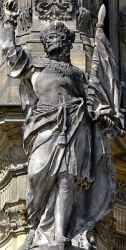
Vaceslav, Vaclav, Wenzel, Wenceslas, Václav
Son of Vratislav I, Duke of Bohemia, whose family had been converted by Saint Cyril and Saint Methodius, and Drahomira, daughter of a pagan chief; she was baptized on her wedding day, but who apparently never seriously took to the faith. Grandson and student of Saint Ludmilla. Duke of Bohemia, ascending to power when his father was killed during a pagan backlash against Christianity, which he fought against with prayer and patience. Murdered by his brother Boleslaus at the door of a church; killed for political reasons, but normally listed as a martyr since the politics arose from his faith. Miracles reported at his tomb. Subject of the Christmas carol Good King Wenceslas. His memorial is also Statehood Day in the Czech Republic.
907 at Prague, Bohemia (in Czech Republic)
28 September 929 at Brandýs nad Labem-Stará Boleslav, Bohemia (in Czech Republic)
• brewers
• Bohemia
• Czech Republic
• Czechoslovakia
• Moravia
• Prague, Czech Republic, archdiocese of
• Prague, Czech Republic, city of
• banner
• crown
• eagle
• staff
• books
• medals and pendants, page 1,
page 2 and
page 3
• rosaries
At the death of Vratislaus, the people of Bohemia made his son Wencelsaus their king. He was by God's grace a man of utmost faith. He was charitable to the poor, and he would clothe the naked, feed the hungry, and offer hospitality to travelers according to the summons of the Gospel. He would not allow widows to be treated unjustly; he loved all his people, both rich and poor; he also provided for the servants of God, and he adorned many churches. The men of Bohemia, however, became arrogant and prevailed upon Boleslaus, his younger brother. They told him, "Your brother Wenceslaus is conspiring with his mother and his men to kill you." On the feasts of the dedication of the churches in various cities, Wenceslaus was in the habit of paying them a visit. One Sunday he entered the city of Boleslaus, on the feast of Saints Cosmas and Damian, and after hearing Mass, he planned to return to Prague. But Boleslaus, with his wicked plan in mind, detained him with the words, "Why are you leaving brother?" The next morning when they rang the bell for matins, Wencelaus, on hearing the sound, said, "Praise to you, Lord; you have allowed me to live to this morning." And so he rose and went to matins. Immediately Boleslaus followed him to the church door. Wenceslaus looked back at him and said, "Brother, you were a good subject to me yesterday." But the devil had already blocked the ears of Boleslaus, and perverted his heart. Drawing his sword, Boleslaus replied, "And now I intend to be a better one!" With these words, he struck his brother's head with his sword. But Wenceslaus turned and said, "Brother, what are you trying to do?" And with that he seized Boleslaus and threw him to the ground. But one of Boleslaus' counselors ran up and stabbed Wenceslaus in the hand. With his hand wounded, he let go of his brother and took refuge in the church. But two evil men struck him down at the church door; and then another rushed up and ran him through with a sword. Thereupon, Wenceslaus died with the words, "Into your hands, O Lord, I commend my spirit." - from an old Slavic legend about Saint Wenceslaus
Good King Wenceslaus
Good King Wenceslas looked out, on the Feast of Stephen,
When the snow lay round about, deep and crisp and even;
Brightly shone the moon that night, tho' the frost was cruel,
When a poor man came in sight, gath'ring winter fuel.
"Hither, page, and stand by me, if thou know'st it, telling,
Yonder peasant, who is he? Where and what his dwelling?"
"Sire, he lives a good league hence, underneath the mountain;
Right against the forest fence, by Saint Agnes' fountain."
"Bring me flesh, and bring me wine, bring me pine logs hither:
Thou and I will see him dine, when we bear them thither."
Page and monarch, forth they went, forth they went together;
Through the rude wind's wild lament and the bitter weather.
"Sire, the night is darker now, and the wind blow stronger;
Fails my heart, I know not how; I can go no longer."
"Mark my footsteps, my good page. Tread thou in them boldly
Thou shalt find the winter's rage freeze thy blood less coldly."
In his master's steps he trod, where the snow lay dinted;
Heat was in the very sod which the saint had printed.
Therefore, Christian men, be sure, wealth or rank possessing,
Ye who now will bless the poor, shall yourselves find blessing.
https://catholicsaints.info/saint-wenceslaus-of-bohemia/
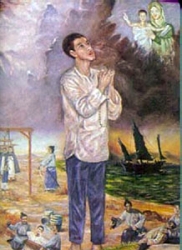
Laurence, Lawrence
Born to a Chinese father and Filipino mother, both Christians, Lorenzo learned Chinese and Tagalog at home, Spanish from the Dominicans whom he served as altar boy and sacristan. Professional calligrapher and document transcriptionist. Member of the Confraternity of the Holy Rosary. Married layman, and the father of two sons and a daughter.
For unclear reasons, Lorenzo was accused of murder. He sought asylum on board ship with three Dominican priests, Saint Antonio Gonzalez, Saint Guillermo Courtet, and Saint Miguel de Aozaraza, a Japanese priest, Saint Vicente Shiwozuka de la Cruz, and a layman named Saint Lazaro of Kyoto, a leper. Only when they were at sea did he learn that they were going to Japan during a time of intense Christian persecution.
Lorenzo could have gone to Formosa (modern Taiwan), but feared the Spaniards there would hang him, and so stayed with the missionaries as they landed at Okinawa. The group was soon exposed as Christian, arrested, and taken to Nagasaki, Japan. They were tortured in several ways for days. Lawrence and the Japanese priest broke at one point, and were ready to renounce their faith in exchange for release, but after heir moment of crisis, they reclaimed their faith and defied their tormentors. First canonized Filipino martyr.
c.1600 at Binondo, Manila, Philippines
• 29-30 September 1637 at Nagasaki, Japan by being crushed over a period of three days while hanging upside down
• body burned, ashes thrown into the Pacific Ocean
• 18 October 1987 by Pope John Paul II
• the canonization miracle involved the healing Cecily Alegriae Policarpio from cerebral paralysis
• books
• holy cards
• medals and pendants
Governor: "If we grant you life, will you renounce your faith?"
Lawrence: "That I will never do, because I am a Christian, and I shall die for God, and for him I will give many thousands of lives if I had them. And so, do with me as you please."
God our loving Father, we praise you! We thank you for crowning our Filipino brother, Lorenzo Ruiz with martyrdom. Through his intercession, enable us by your Holy Spirit of Love, to live and die for you and your beloved people, hoping that we may be transformed day by day into the likeness of your Son, Jesus. United with him around the table of his Eucharistic Sacrifice, inspire us to surrender ourselves to be taken by you, Father, to be blessed, broken, and shared with and for others in love and unity, so that our beloved country may attain that peace we long for. We ask this in the name of Jesus Christ our Lord in the unity of the Holy Spirit, one God for ever and ever. Amen.
https://catholicsaints.info/saint-lorenzo-ruiz-of-manila/
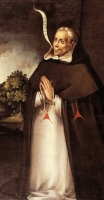
• Simón Ruiz de Rojas
• Simon of Rojas
A pious child, his first words, at age 14 months, were reported to be Ave Maria. From his youth and throughout his life he loved to visit Marian shrines. Joined the Trinitarians in Valladolid, Spain at age 12, and made his religious profession on 28 October 1572. He studied at the University of Salamanca from 1573 to 1579, and was ordained a priest in 1577. Taught philosophy and theology in Toleda, Spain from 1581 to 1587. From 1588 to 1624, he served as superior of several Trinitarian convents in Castile and Andalusia, and served three periods as Apostolic Visitor to the regions.
His theological studies and contemplation of the mission and cooperating of the Blessed Virgin Mary led his to declare that he was a “slave” of Mary, and he founded the Congregation of the Slaves of the Most Sweet Name of Mary on 14 April 1612 for lay people who wanted to help lead people to God through devotion to Mary; the Congregation spread widely, included kings and princes, and helped to care for the poor. He caused the printing of thousands of images of the Blessed Virgin Mary with the caption “Ave Maria” and had them distributed inside and outside Spain. He made and distributed rosary crowns of 72 blue beads on white cord with symbols of the Assumption and of the Immaculate Conception; there was a tradition at the time Mary had lived to age 72.
Chosen the tutor of the royal infants of Spain in 1619. Elected Trinitarian Provincial of Castile on 12 May 1621. Confessor of Queen Isabella of Bourbon on 1 January 1622. Though a member of the royal court, he lived in poverty, travelled on foot everywhere he went, and spent whatever he had for the care of the poor.
28 October 1552 in Valladolid, Spain
28 September 1624 in Madrid, Spain of natural causes
3 July 1988 by Pope John Paul II
https://catholicsaints.info/saint-simon-de-rojas/
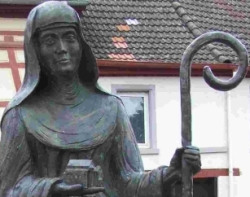
• Lioba of Wimborne
• Leoben, Liobgytha, Liobgetha, Truthgeba
Born to the Wessex nobility to parents who had long prayed for a child. Relative of Saint Boniface with whom she corresponded for several years. Educated at the convent of Minster-in-Thanet and in Wimborne in Dorset, England. Nun at Wimborne at a time when Saint Tetta of Wimborne served as abbess.
In 748 Lioba led a group of 30 nuns, one of whom was Saint Agatha of Wimborne to Germany to help the missionary work of Saint Boniface and found convents. They based their work at Bischofsheim in Würzburg, Franconia, followed the Benedictine Rule, and Lioba served as abbess. Noted for her intelligence, her endless optimism and positive attitude for the work, and her constant study of the scriptures. Her work and the houses she founded were instrumental in the conversion of Germany to Christianity.
Lioba retired from her position in 776 only to start another house Schornsheim, Mainz. Visited the court of Charlemagne in Aachen, Germany and became a close friend of Empress Hildegard. The Benedictines of Saint Lioba are based in Frederiksberg, Denmark.
c.710 in Wessex, England as Truthgeba (= God's gift)
• 28 September 782 in Schornsheim, Germany of natural causes
• buried next to Saint Boniface in Fulda, Germany
• relics moved in 819
• relics moved in 839
• relics later moved to Saint Peter Berg Abbey in Fulda, Germany
Benedictine abbess with a book (indicative of her scriptural knowledge), a clock, and lightning (which she once miraculously turned aside)
https://catholicsaints.info/saint-lioba-of-bischofsheim/
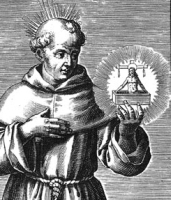
• Bernardino of Feltre
• Martin Tomitani
Born to the nobility, the eldest of nine children, he grew up with a speech impediment. After hearing Saint James of the Marches preach at Padua, Italy during Lent in 1456, he felt a call to the religious life. Joined the Order of Friars Minor in May 1456. Teacher. Studied at Mantua, Italy. Ordained in 1463. His speech impediment miraculously cured, and he became a travelling preacher throughout Italy, noted for his fiery sermons against usury. He organized more than thirty monti di pietá throughout Italy to give people an alternative to high-interest lenders.
1439 at Feltre, Italy as Martin Tomitani
28 September 1494 of natural causes
• 13 April 1654 by Pope Innocent X (cultus confirmed)
• 1728 by Pope Benedict XIII (beatified)
• bankers
• pawnbrokers
• green hill of three mounds, with a cross on each
• man holding monte di pietà, that is, a little green hill composed of three mounds and on the top either a cross or a standard with the inscription: Curam illius habe
https://catholicsaints.info/blessed-bernardine-of-feltre/
• Conval the Confessor
• Conwall...
Son of an Irish prince. Spiritual student of Saint Kentigern. Archdeacon and priest. One day as he stood on the edge of the Irish sea he asked for God's guidance for his life. The stone on which he was standing broke loose and carried him to Inchinnan where a chapel stands to commemorate it. Evangelized throughout East Renfrewshire, Scotland where there still exist "Conval wells" in Barrhead and Thornliebank.
Irish
c.630 in Scotland of natural causes
East Renfrewshire, Scotland
Taking to heart Christ's holy command, thou didst preach His Gospel to the nation of the Picts, O Father Conwall, setting us a laudable example. Pray that we may be granted strength also to witness for Christ until our last breath, that having lived only for Him, we may be made worthy to enter His Kingdom. - Orthodox Christian dismissal hymn on the feast of Saint Conwall
https://catholicsaints.info/saint-conval-of-strathclyde/
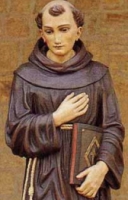
Francis of Caldarola
Francis grew up in a poor farming community where he saw many people become enslaved to high-interest money lenders and pawn dealers. Franciscan friar. Known as a powerful preacher and a peacemaker between feuding people, families and clans; he said his secret to peace-making was to talk to the people by day and then spend his nights in prayer. Worked with Blessed Bernardino da Feltre to set up the alternatives to pawn shops.
1424 in Caldarola, Macerata, Italy
12 September 1507 in the Franciscan convent in Colfano, Italy of natural causes
• miracles reported at his graves, and devotion to him was recorded as early as 1511
• 1634 by Pope Urban VII (cultus confirmation)
• 1 September 1843 by Pope Gregory XVI (cultus confirmation)
https://catholicsaints.info/blessed-francis-piani/
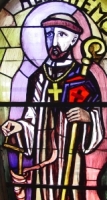
Dietmar, Theodinarus, Theodmarus, Thimo
Born to the Bavarian nobility. Benedictine monk at Niederaltaich Abbey. Renowned painter, engraver, sculptor, and artist in metal. Abbot of Saint Peter's Abbey in Salzburg, Austria in 1077. Archbishop of Salzburg in 1090. Attended the Council of Piacenza in 1095 which took place during a period of turmoil over lay investiture and the appointment of illegitimate bishops. Imprisoned in 1097 and exiled for loyalty to Pope Gregory VII. Crusader in 1101. Captured at Ascalon. Tortured and martyred in Corozain for refusing to convert to Islam.
c.1040 in Bavaria, Germany
1102 at Corozain, Palestine
• engravers
• sculptors
https://catholicsaints.info/blessed-thiemo-of-salzburg/
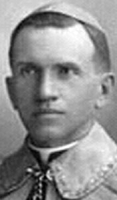
Niceta, Nykyta, Mykyta
Greek-Catholic. Studied theology in Vienna and Innsbruck, Austria, graduating in 1905. Ordained on 25 October 1905. First bishop for Ukrainian Catholics in Canada on 15 July 1912. Auxiliary bishop of Lviv, Ukraine on 14 October 1912. Vicar General of the Metropolitan Curia in Lviv in 1928. Arrested for his faith and sentenced to eight years in the Soviet concentration camps on 11 April 1945. Martyr.
7 June 1877 in Dobomirka, Zbarazh District, Poland (modern Ukraine)
1 October 1949 in a Soviet concentration camp in Karaganda, Kazakhstan
27 June 2001 by Pope John Paul II in Ukraine
https://catholicsaints.info/blessed-nikita-budka/
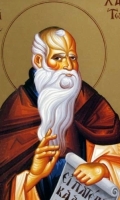
Chariton the Confessor
Hermit in the Kidron Valley near Jericho. His reputation for holiness atrracted so many would-be spiritual students that he retreated to the desert of Jericho. Founded the Souka abbey at wadi Chareitun near Bethlehem, Palestine, and served as its first abbot; he founded several houses in the desert of Judea. Known for spending his days in manual labour and prayer, fasting till after sunset, and even then eating little and plainly.
Iconium, Lycaonia, Asia Minor
c.350 of natural causes at an advanced age
https://catholicsaints.info/saint-chariton-of-palestine/
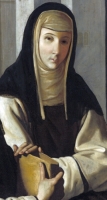
Daughter of Saint Paula of Rome and Roman senator Toxotius. Sister of Saint Blaesilla. Spiritual student of Saint Jerome in 382. Made a personal vow of perpetual virginity. Spoke Latin and Greek, and could read Hebrew. Travelled with Paula and Jerome to the Holy Land where she helped with the Vulgate Bible translation, working as Jerome's housekeeper, reading and writing for him when his eyesight began to fail. When Paula died in 404, Eustochium took over the spiritual direction of three women's communities formerly guided by her mother.
c.369 at Rome, Italy
c.419 at Bethlehem of natural causes
https://catholicsaints.info/saint-eustochium/
Salonio
Son of Galla, who became a nun late in life, and of Saint Eucherius of Lyon; brother of Saint Veranus of Vence. Educated at Lérins Abbey where he became a monk. Bishop of Geneva, Switzerland in 439. Attended the Council of Orange in 441. Attended the Councils of Vaison in 442 and in 451. Supported the work of Pope Saint Leo the Great. Wrote Bible commentaries on the books of Proverbs and Ecclesiastes, and was so well known in theological and intellectual circles that other works of the time were dedicated to him.
c.400
mid-5th century in Geneva, Switzerland of natural causes
https://catholicsaints.info/saint-salonius-of-geneva/
Annemund, Anemundo, Annemundus, Chamond, Delphinus, Ennemond
Born to the nobility, the son of Sigon, a prefect in Lyons, France; his brother was Count Dalfin of Lyons. Annemond grew up in the court of King Dagobert I, and councilor to King Clovis II. Friend of Saint Wilfrid of York. Archbishop of Lyons, France. Murdered by Ebroin in the turmoil following the death of Clovis. Saint-Chamond, Loire, France is named in his honour.
• 657 in Châlon-sur-Saône, France
• relics enshrined by Saint Wilfrid of York
https://catholicsaints.info/saint-annemond-of-lyons/

Bishop of Auxerre, France, probably consecrated in August 452, and then serving for 30 years.
• 28 September 482 in Auxerre, France of natural causes
• re-interred in the crypt of the church in Auxerre in 865
• the relics were re-surveyed and recorded in 1636
• the relics were re-surveyed and recorded in 1857
https://catholicsaints.info/saint-alodius-of-auxerre/
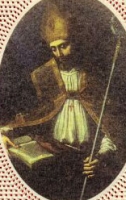
First known bishop of Bologna, Italy, consecrated by Pope Saint Dionysius, c.260.
• c.268 of natural causes
• relics translated from the Church of the Crucifix in Saint Stephen to the cathedral of Saint Peter in Bologna, Italy c.1500
• buried next to Saint Faustinianus
https://catholicsaints.info/saint-zama-of-bologna/
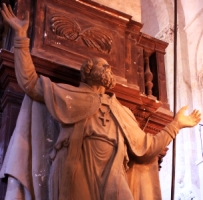
Essuperio, Exsuperius, Soupire
Bishop of Toulouse, France. Known for his charity, including aid to the poor in Egypt and Palestine. Saint Jerome thought highly of him, and dedicated one of his Bible commentaries to him.
411
https://catholicsaints.info/saint-exuperius-of-toulouse/
Conald, Cunialdo
Seventh-century missionary priest in the region of Bavaria in modern Germany and Austria. Worked with Saint Rupert of Salzburg.
Ireland, Scotland, France or Germany (records vary quite a bit)
• c.718 at Salzburg, Austria of natural causes
• relics transferred to the church of Saint Rupert in 773–774
https://catholicsaints.info/saint-chuniald/
Gisilario
Seventh-century missionary priest in the region of Bavaria in modern Germany and Austria. Worked with Saint Rupert of Salzburg.
Ireland, Scotland, France or Germany (records vary quite a bit)
• c.718 at Salzburg, Austria of natural causes
• relics transferred to the church of Saint Rupert in 773–774
https://catholicsaints.info/saint-gislar/
Brother of Blessed Desiderio Franco. Joined the Augustinians in 1362. Monk at the Carbonara convent in Naples, Italy in 1421. Augustinian superior general.
Villafranca Piemonte, Italy
• 1432 of natural causes
• buried at the Carbonara convent in Naples, Italy
https://catholicsaints.info/blessed-christian-franco/
Abbess of Wimborne Abbey during a period when it had over 500 sisters including Saint Lioba of Bischofsheim, Saint Thecla of Kitzingen and Saint Agatha of Wimborne. Sent a contingent of the nuns and gave other help to the missionary work of Saint Boniface in Germany.
c.772
https://catholicsaints.info/saint-tetta-of-wimborne/

Monk at Lérins Abbey. Abbot there in 433. Bishop of Riez, France in 459. Fought Arianism and Pelagianism in his diocese.
c.408 in Brittany, France
c.490
https://catholicsaints.info/saint-faustus-of-riez/
Ninth-century bishop of Auxerre, France.
• c.807 in Auxerre, France of natural causes
• relics enshrined in the church of Saint-Germain in Auxerre
https://catholicsaints.info/blessed-aaron-of-auxerre/
Monk in the monastery in Moyenmoutier, France. Helped found the monastery in the area of Romont in modern Switzerland.
c.690
https://catholicsaints.info/saint-willigod-of-moyenmoutier/
Monk in the monastery in Moyenmoutier, France. Helped found the monastery in the area of Romont in modern Switzerland.
c.690
https://catholicsaints.info/saint-martin-of-moyenmoutier/
Educated in Ireland where he became a monk. Missionary to pagans in Scotland. Bishop, ordained in Rome, Italy.
Scottish
Aberdeen, Scotland
https://catholicsaints.info/saint-machan/
Martyred in the persecutions of Alexander Severus.
scourged to death in 223 in Rome, Italy
https://catholicsaints.info/saint-privatus-of-rome/
Salomon, Salonius
First bishop of Genoa, Italy.
c.269
https://catholicsaints.info/saint-solomon-of-genoa/
Second-century bishop of Auch, France.
Bilbao, Spain
https://catholicsaints.info/saint-paternus-of-auch/
One of a group of 28 Christians martyred in the early days of the Church in Asia Minor.
https://catholicsaints.info/saint-bardomianus/
One of a group of 22 martyrs.
https://catholicsaints.info/saint-laurence-of-north-africa/
One of a group of 22 martyrs.
https://catholicsaints.info/saint-martial-of-north-africa/
One of a group of 28 Christians martyred in the early days of the Church in Asia Minor.
https://catholicsaints.info/saint-eucarpus/
Martyr.
Rome, Italy
https://catholicsaints.info/saint-stacteus/
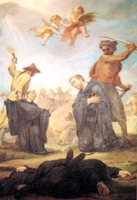
The first Augustinian missionaries arrived in Japan in 1602 and met with immediate success; many were brought to the faith; many of them became Augustinians; and many of them were martyred in the periodic persecutions of Christians. This memorial commemorates all of them, whether they have a sanctioned Cause for Canonization or not. They include
• Blessed Bartolomé Gutiérrez Rodríguez
• Blessed Ferdinand Ayala
• Blessed Francisco Terrero de Ortega Pérez
• Blessed Ioannes Mukuno Chozaburo
• Blessed Laurentius Kaida Hachizo
• Blessed Mancius Yukimoto Ichizaemon
• Blessed Martín Lumbreras Peralta
• Blessed Melchor Sánchez Pérez
• Blessed Michaël Ichinose Sukezaemon
• Blessed Pedro de Zúñiga
• Blessed Petrus Sawaguchi Kuhyoe
• Blessed Thomas Terai Kahyoe
• Blessed Vicente Simões de Carvalho
• Saint Magdalena of Nagasaki
• Blessed Thomas Jihyoe of Saint Augustine
https://catholicsaints.info/augustinian-martyrs-of-japan/
A group of 30 soldiers and 7 civilians who were murdered together for their faith. The names that have come down to us are - Alexander, Alphinus, Heliodorus, Mark, Neon, Nicon and Zosumus.
c.303 at Antioch, Pisidia (in modern Turkey)
https://catholicsaints.info/martyrs-of-antioch-28-september/
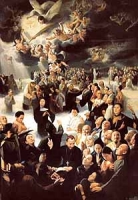
A common memorial for the hundreds of the faithful, lay and clergy, who have died for their faith in the last couple of centuries in China.
1 October 2000 by Pope John Paul II
https://catholicsaints.info/martyrs-of-china/
Thousands of people were murdered in the anti-Catholic persecutions of the Spanish Civil War from 1934 to 1939. I have pages on each of them, but in most cases I have only found very minimal information. They are available on the CatholicSaints.Info site through these links:
• Blessed Amalia Abad Casasempere de Maestre
• Blessed Francesc Xavier Ponsa Casallach
• Blessed Josep Casas Juliá
• Blessed Josep Casas Ros
• Blessed Josep Tarrats Comaposada
• Blessed María Fenollosa Alcaina
• Antonio of Almansa
• Valentino Rovira
CatholicSaints.Info Portable Edition